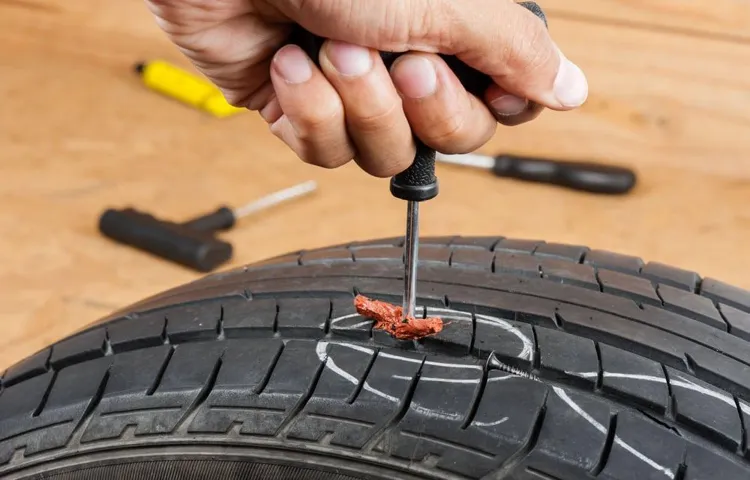Have you ever found yourself driving down the road and suddenly noticing something sharp protruding from your tire? It’s a harrowing experience that can leave you questioning just how far you can drive on a plugged tire. A puncture in your tire can happen at any time, and while it’s never convenient, it’s essential to know how long you can keep driving on a plugged tire. In this blog post, we’ll explore the limits of a plugged tire and what you need to know to stay safe on the road.
So, buckle up and let’s dive in!
Table of Contents
Understanding Plugged Tires
If you have ever encountered a flat tire, you know how inconvenient it can be. But what if your tire has been plugged? How long can you drive on a plugged tire? The answer depends on various factors. A plugged tire can continue to function normally for a while, depending on the location of the puncture and the size of the hole.
However, driving on a plugged tire for too long can be dangerous. It’s because the plug is not a permanent fix and can only serve as a temporary solution. If you have a plugged tire, it’s best to take your vehicle to a tire professional as soon as possible to assess the damage and decide if it’s safe to continue driving on it.
In general, it’s recommended to replace a plugged tire with a new one as soon as possible to ensure your safety while driving.
What is a plugged tire?
A plugged tire is simply a tire that has had a puncture repaired using a plug. Punctures can be caused by a number of things, such as nails or screws on the road, shards of glass, or even just wear and tear on the tire itself. The good news is that if your tire is punctured and it’s not in the sidewall, it can often be repaired using a plug.
A plug is a small, flexible rubber patch that is inserted into the puncture site and then sealed into place. The result is a strong, permanent seal that prevents air from escaping the tire. It’s important to note that while plugged tires can often be safely repaired, it’s critical to have any repair done by a professional.
Failure to properly repair a tire can result in a blowout while driving, which can be extremely dangerous. So if you notice a puncture in your tire, be sure to take it to a reputable tire shop or mechanic to have it professionally patched and plugged.
How is a tire plugged?
If you’ve ever had a flat tire, you know the inconvenience of having to change it or take it to a shop for repair. But did you know that a tire can often be fixed using a simple plug? The process of plugging a tire begins by finding the source of the leak, usually by submerging the tire in water and looking for bubbles. Once the puncture is found, a specialized tool is used to ream out the hole, ensuring that it’s free of debris and ready to accept a plug.
The plug itself is a small, rubber-coated piece of string that’s inserted into the hole and then trimmed flush with the tire’s surface. With the plug in place, the tire is inflated and then checked for leaks once again. If all is well, you’re good to go! Keep in mind that not all punctures can be plugged – if the damage is too severe or close to the sidewall, a patch or replacement may be necessary.
As with any tire repair, it’s important to have a professional assess the situation and make the appropriate recommendations.
Is it safe to drive on a plugged tire?
Plugged Tires Have you ever been in a situation where you get a punctured tire and the thought of replacing it could be daunting? Well, fret not because utilizing the plug method for your tire could be just the solution. A plugged tire is deemed safe to drive on, but only under particular circumstances. Minor punctures like those caused by nails or screws, which are within the tread depth of about 6 millimeters, can be repaired with the use of a plug.
However, if the puncture is larger, or the sidewall of the tire is damaged, then the plug method would not be effective, and the tire should be replaced immediately to avoid the risk of a blowout. It’s not only cheaper to get your tire plugged, but it’s also environmentally friendly since it doesn’t require the disposal of the tire. However, it’s important to note that a plugged tire is not a permanent solution, and it’s recommended to get the tire checked out by a professional as soon as possible after plugging it.
Overall, a plugged tire is safe to drive on, but it’s essential to get it evaluated by a professional to ensure it won’t cause any further issues on the road.
Factors to Consider When Driving on a Plugged Tire
When driving on a plugged tire, there are several factors to consider. Firstly, it’s important to understand that a plugged tire is not a permanent fix and merely a temporary solution until a proper repair can be made. The extent of the damage and location of the puncture will play a significant role in determining how long you can drive on a plugged tire.
If the puncture is close to the sidewall or in an area with heavy load-bearing, driving on a plugged tire may not be safe, and immediate replacement would be necessary. Additionally, driving on a plugged tire can affect the overall balance of the vehicle and cause uneven wear on the tires. Therefore, it’s crucial to have the tire checked by a professional and replaced as soon as possible.
In general, it’s best to limit driving on a plugged tire and have it repaired as soon as possible. Remember, safety is always the top priority when it comes to driving.
Size and location of the puncture
When it comes to driving on a plugged tire, there are several factors to consider, with the size and location of the puncture being crucial. A small puncture in the tread area can be safely plugged, but larger punctures in the sidewall or shoulder areas may be unsafe and require a replacement tire. Additionally, if the puncture is located near the edge of the tire, it may compromise the structural integrity, making it unsafe to drive on even if it’s a small puncture.
It’s important to have a professional assess the puncture and determine if it’s safe to drive on or if a replacement tire is necessary. Always err on the side of caution, as driving on a compromised tire can lead to further damage or even a blowout, putting yourself and others on the road at risk. Remember to check your tire pressure regularly, as low pressure can increase the risk of a puncture and compromise the effectiveness of a plugged tire.
Age of the tire
When it comes to driving on a plugged tire, there are a few factors that you need to take into consideration. One of the most important factors is the age of the tire. It’s important to know how old your tire is, as well as how long it has been since the tire was last inspected.
Tires can wear out over time, and if the tire is too old or in poor condition, it may not be safe to drive on, even if it has been plugged. A tire that is over six years old or has been driven for more than 50,000 miles should be replaced, regardless of whether it has been plugged or not. If you’re unsure about the age or condition of your tire, it’s best to have it checked by a professional before driving on it.
Remember, safety should always be your top priority when it comes to driving on plugged tires.
Type of vehicle and driving conditions
When driving on a plugged tire, there are several factors to consider, including the type of vehicle and driving conditions. The weight of the vehicle plays a significant role in determining how a plugged tire will perform on the road. Heavier vehicles put more strain on the tire, and the plug may not hold up well under these conditions.
Additionally, the driving conditions can also affect the quality of the plug. Potholes, debris on the road, and other rough driving conditions can damage a plugged tire, leading to an eventual blowout. It is important to monitor the tire’s pressure and examine the plug regularly to ensure it remains secure.
Ultimately, the longevity of a plugged tire depends on proper maintenance and smart driving habits. By taking necessary precautions and avoiding dangerous driving conditions, drivers can help extend the life of a plugged tire and stay safe on the road.
Guidelines for Driving on a Plugged Tire
If you’ve had the unfortunate experience of getting a punctured tire, then you know how frustrating it can be. However, if you’ve managed to get it repaired by a professional, you may be wondering how long you can drive on a plugged tire. Although there isn’t a definitive answer to this question, it’s generally recommended that you treat a plugged tire with caution.
Most experts advise that you shouldn’t drive on a plugged tire for longer than 100 miles at a time. This is because a plugged tire is more susceptible to blowouts and other serious issues. It’s also important to remember that a plugged tire is not as reliable as a brand-new tire, so it’s best to err on the side of caution and have it replaced as soon as possible.
Overall, it’s recommended that you monitor the condition of your plugged tire regularly, and if you notice any signs of wear or damage, have it replaced immediately.
Check the tire pressure regularly
As a responsible driver, it’s important to make sure that your tires are in good condition before hitting the road. One of the most essential aspects of this is checking your tire pressure on a regular basis. Driving on a plugged tire can be risky, but sometimes it’s unavoidable.
If this is the case for you, there are a few guidelines you should follow to keep yourself and others safe. Firstly, be sure to avoid any sharp turns or sudden movements when driving on a plugged tire. Stick to the speed limit and try to maintain a constant speed as much as possible.
It’s also a good idea to limit your driving to shorter distances and avoid any long trips until you can get your tire properly repaired or replaced. Remember, a plugged tire is only a temporary solution, so it’s important to take care of it until you’re able to make a more permanent fix. By following these guidelines, you can drive safely and confidently on a plugged tire without putting yourself, your passengers, or other drivers at risk.
Avoid high speeds and sharp turns
When you are driving on a plugged tire, it is important to follow certain guidelines to ensure your safety and the longevity of your tire. One of the most crucial tips is to avoid high speeds and sharp turns. Plugged tires have a higher risk of blowouts, especially when they are pushed beyond their limits.
Therefore, it is recommended to drive at a moderate pace and avoid sudden maneuvers that could cause your tire to fail. Additionally, it is important to keep an eye on your tire pressure and check it regularly to ensure that it is not losing air. Underinflated tires are more prone to damage, especially when driving on rough terrain or uneven roads.
So, make sure to keep your plugged tire properly inflated and avoid overloading your vehicle. By following these simple guidelines, you can drive safely on a plugged tire and avoid any potentially dangerous situations on the road.
Limit the distance driven on a plugged tire
When you’ve got a flat tire, it can be tempting to just stick in a plug and get on with your day. That being said, it’s important to know that driving on a plugged tire does come with its own set of risks. While a plug can keep the tire inflated and functioning for a little while longer, it’s still important to limit how far you drive.
In general, most experts agree that you should try not to exceed 50-60mph and no further than 50 miles on a plugged tire. When you drive on a plugged tire, there’s the potential for the tire to heat up and experience a blowout or bust. More specifically, the heat can cause the plug to break loose, resulting in a loss of tire pressure.
This could cause you to lose control of your vehicle, putting you and other drivers at risk. So while it might be tempting to keep going, it’s important to be cautious and get to a safe place as soon as possible. Remember, safety always comes first.
Replace the tire as soon as possible
If you find yourself driving on a plugged tire, it’s important to take precautions and get it replaced as soon as possible. While it may seem like a quick fix, a plugged tire is not meant to be a permanent solution. Driving on a plugged tire can be dangerous, as it can compromise the tire’s structural integrity and lead to a blowout.
It’s recommended that you avoid high speeds and sharp turns when driving on a plugged tire, and monitor the tire’s pressure frequently. If the tire starts to lose pressure, it’s a sign that the plug may have failed and you need to get it repaired or replaced immediately. Remember that a plugged tire is not a long-term solution, and it’s always best to have a professional inspect and repair or replace the tire as soon as possible to ensure your safety on the road.
Conclusion
In conclusion, driving on a plugged tire is like walking on thin ice. You might be able to make it to your destination without incident, but it’s risking disaster if you hit a bump or pothole along the way. It’s best to get the tire replaced as soon as possible to ensure your safety on the road.
Remember, prevention is always better than cure!”
FAQs
Can you drive on a tire with a plug?
Yes, you can drive on a tire with a plug for a short period.
How long can you drive on a plugged tire?
It is recommended that you drive on a plugged tire for no more than 50-100 miles.
Is it safe to drive on a plugged tire?
It is generally safe to drive on a plugged tire as long as the plug is properly installed and the tire is not severely damaged.
Can I repair a tire with more than one plug?
No, it is not recommended to repair a tire with more than one plug. It is best to replace the tire.
Can a plugged tire be repaired again?
It is not recommended to repair a tire that has already been plugged as it may compromise the tire’s structural integrity.
How much does it cost to plug a tire?
The cost of plugging a tire varies depending on the type of tire and the extent of the damage, but it can range from $10 to $50.
Can a tire plug be used as a long-term solution?
No, a tire plug is not a permanent solution and should only be used as a temporary fix until the tire can be properly repaired or replaced.



